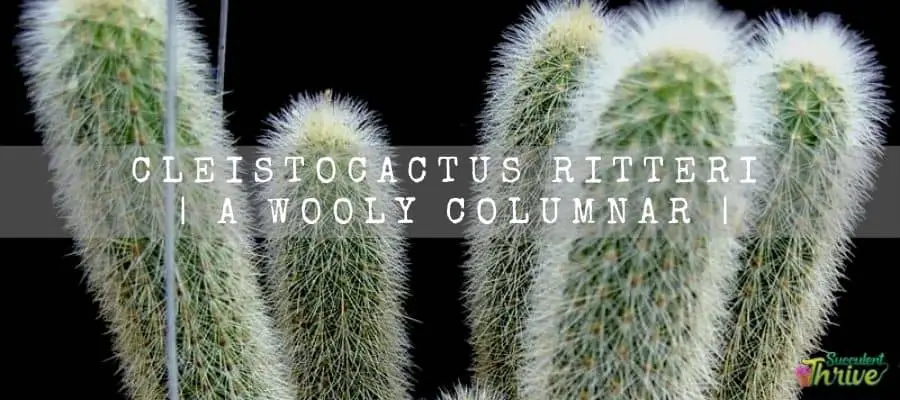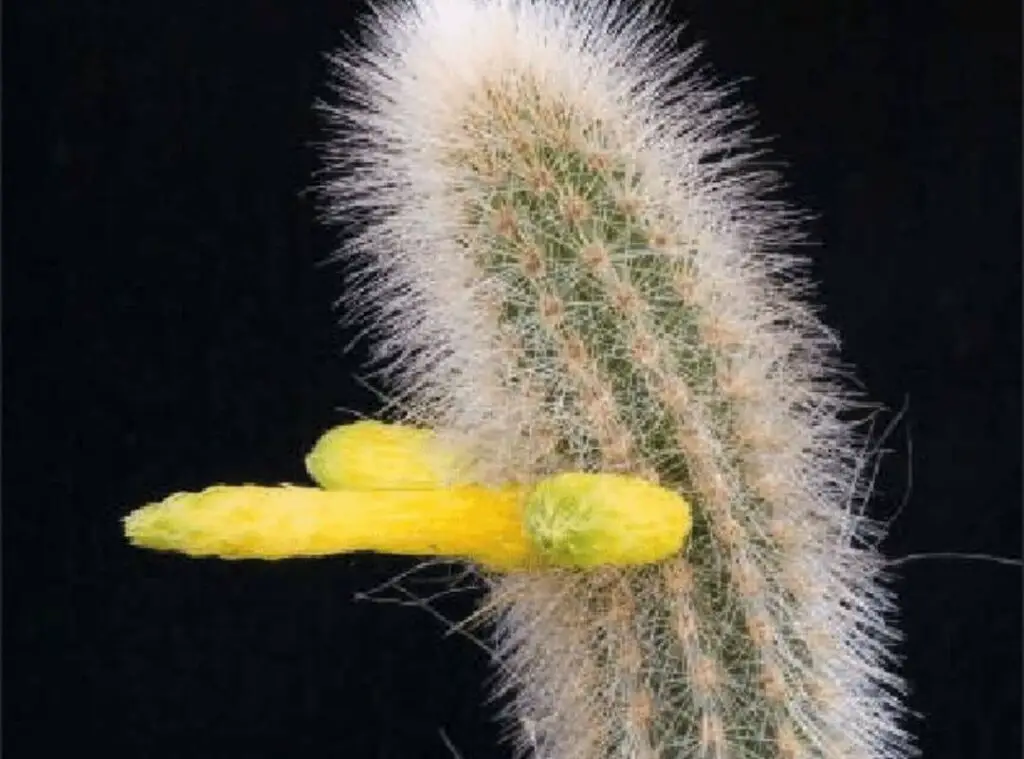Cleistocactus ritteri, also referred to as Ritter’s Cleistocactus, is one of my favorite plants to grow. The brilliant red and orange blossoms of this lovely cactus are its most notable feature. It is an easy-to-care-for plant that is ideal for beginners to cactus upkeep.

In my collection, I have a handful of these plants, and I adore them. Every time I look at them, they add a splash of color to my house and make me happy. I wholeheartedly endorse getting a Cleistocactus ritteri for your plant collection. So, brace yourself and get ready to learn on these spectacular plants
One look care guide
| Botanical Name | Cleistocactus ritteri |
| Plant Type | Succulent / cactus |
| Mature Size | 1 meter height and 2-3 cm in diameter |
| Sun Exposure | Full sunlight to partial shade |
| Soil Type | Well draining , sandy |
| Soil pH | Neutral |
| Bloom Time | Mid spring to late spring and in early summer |
| Flower Color | Pale yellow and in bright yellow |
| Hardiness Zones | Zone 9b-11 |
| Native Area | Bolivia |
| Toxicity | Not toxic |
| Average price | $ 12 |
How do I identify Cleistocactus ritteri?
Cleistocactus ritteri forms as a shrubby columnar cactus. Further, they would branch out basally along with some erect-forming branches. They would rise to a maximum height of 1 meter. Besides, they would be about 2-3 cm in diameter. Moreover, they would have bristly soft spines too. In addition to these, they produce flowers in yellow as well. Cleistocactus ritteri stems would be slim and form an erecting form. They would be bright green.
Apart from that they would comprise 12-16 ribs. Their areolas would be first dark in color, and they would become gray, white in color as they mature.
Moreover, Cleistocactus ritteri would consist of five central spines. They would be yellow in color and 1 cm in length. Cleistocactus ritteri would have about 30 radial spines. They would be more like hair and white in color. Moreover, they would be 3 cm in length.
The spination of the Cleistocactus ritteri defends them from the harsh sunlight. Further they would trap an air layer next to the cactus body which is crucial for the plants well being
Cleistocactus ritteri blossoms have flowers that tend to take a pointed shape. Furthermore, they may form in a slightly downward direction as well. Those flowers will form in green, yellow, and lemon yellow colors. Ultimately, they would produce a fruit that tends to take a globose shape. They would also be yellow and 1.5 cm in diameter.
Growth rate
Cleistocactus ritteri usually grows at a slow speed. Let me give you evidence. I discovered an article about Cleistocactus ritteri and its rapid growth in the Cactus and Succulent Journal by James D. Mauseth. According to James, its growth started in March, and at its highest point, shoot tips were churning out 8.4 leaves per day, with fewer than three hours between the production of two successive leaves at the shoot apex.
| Species | Leaves per day | Hours from one leaf to the next |
| Cleistocactus strausii | 10 | 2.4 |
| Cleistocactus ritteri | 8.4 | 2.9 |
| Austrocephalocereus dybowskii | 3.4 | 7 |
| Notocactus scopa | 2.3 | 10.4 |
| Pilosocereus tillianus | 1.3 | 18.5 |
| Harrisia martinii | 1.0 | 24.0 |
| Cereus forbesii | 0.9 | 26.7 |
| Pereskia sacharosa | 0.7 | 34.3 |
How do you take care of Cleistocactus ritteri?
Light Requirement
It is critical that you plant the Cleistocactus ritteri in a location where it will receive plenty of sunlight. Ideally, they need to gain bright, indirect sunlight for the vigorous growth of the plants. Having said that, if you experience any extreme summer conditions, the ideal thing that you could do is to grow them along with a bit of shade, especially during the intensely hot hours of the day. They can withstand the bright, full sunlight only during the early morning hours of the day, as it is not that intense.
Temperature and humidity
Cleistocactus ritteri can tolerate frost conditions. In fact, they are tolerant of temperatures up to -7 degrees Celsius. If they are dry, they may be able to tolerate even lower temperatures. Having said that, when you cultivate them, I recommend not exposing them to colder conditions that are less than 0 degrees Celsius, as then it would be harmful for the plants.
If you accidentally expose them to frost for extended periods it would create an unhealthy impact on the plants. It will result in anti-aesthetic spots on the epidermis.
Is it cold hardy?
Cleistocactus ritteri are cold hardy up to -7 degrees Celsius when they grow in the wild.
Zone
Cleistocactus ritteri prefer to grow in USDA hardiness zones 9b-11
Watering Requirement
Cleistocactus ritteri would grow quickly and vigorously if well watered. So, I recommend watering them regularly during the summer while ensuring that you are allowing the soil to dry before you irrigate them again. You need to keep them dry all winter. You could water the plants once every few weeks during the fall. Refrain from overwatering them unless it leads to root rot.
Soil Requirement Type / ph
Cleistocactus ritteri would perform well if you grew them in a rich substrate that has excellent drainage. These are quite susceptible to root rot, and it is important that you grow them in a well-draining soil mix. If you end up providing a poor-draining soil mix, it will retain excess moisture within the pot and lead to root rot. It is preferable to use sterilized soil with a high porosity.
It would result in the healthy growth of the plants. If you wish, you may also use garden soil for this purpose. However, ensure that you are using sterilized garden soil only.. You could add elements such as sand, perlite, and some peat moss to improve the aeration of the soil mix as well as the draining factor.
Pot size Potting and Repotting
I recommend growing Cleistocactus ritteri in pots made of porous material. That will help the plant evaporate the excess moisture into the air at a rapid rate. Hence, I would recommend you go ahead with clay pots to plant the Cleistocactus ritteri. Besides, it should consist of at least one or two draining holes as well. That way, you can be confident that the pot will not retain excess moisture within it.
In terms of repotting the Cleistocactus ritteri plants, it would be best to do it when their roots become cramped. In general, you need to repot them once every two years so that it will provide fresh growing conditions for the plants. Make sure you report them during their active growing season and whether they are only dry. After about one week, you could water the plants.
Where to Plant
Cleistocactus ritteri need to be planted in a place where they can gain plenty of indirect bright sunlight. In addition to that ensure that you are providing a well draining soil mix too.
Fertilizer and time of year
Ideally you need to feed the Cleistocactus ritteri plants with a slow-release fertilizer during spring. It will be adequate for them to thrive well for one whole year.
The selected fertilizer should contain only a less component of Nitrogen. Instead, I recommend using a fertilizer which is high in potassium. Further never feed them when they are dormant as it would lead to unnecessary troubles then.

Flower
Cleistocactus ritteri blossom with flowers in pale yellow and in bright yellow. They would usually bloom in mid spring to late spring and in early summer as well.
Dormancy
Cleistocactus ritteri are winter dormant plants. During winter, you need to let them relax and refrain from feeding them or watering them.
Toxicity
This plant is not known to be toxic.
Common bugs and illnesses
Root rot is a commonly spotted illness that these plants may go through, and overwatering could be the culprit here. Furthermore, if you overwater them, you will cause fungal and bacterial infections. In addition to that, regular pests such as aphids, mealybugs, and scales would invade these plants too. If you come across any, you could simply treat them with regular pest remedies.
How to propagate Cleistocactus ritteri?
You could propagate the Cleistocactus ritteri by using either their stem cuttings or the seeds. If you wish to use the cutting method, you could simply take them off and allow them to be callous. Next, plant them in a well-draining soil mix. If you want to propagate them from seeds, simply sow them in a potting medium made of sand, perlite, peat, and other ingredients.
Next you may sprinkle some water and leave the specimen in a spot where they can gain bright indirect sunlight. They would start to develop roots within three weeks’ time and only after that they would start to grow.
Conclusion
I hope this article was useful for you to educate yourself on how to grow these precious plants well. It is simple, and you only need to supply the basic growing conditions for them.
So, I hope now you are much more confident in handling these plants as well as now you are well equipped with the growing requirements they need. Happy cultivating with Cleistocactus ritteri !
Reference
Mauseth, J.D., 2017. Are some cacti the fastest growing plants in the world?. Cactus and Succulent Journal, 89(1), pp.4-10.
Sánchez, A.G., 2006. Enciclopedia ilustrada de los cactus y otras suculentas: descripción de las especies, hábitat y cuidados de cultivo. Volumen II (Vol. 2). Floramedia.
Read Next : Monanthes Subcrassicaulis | A Cute Little Succulent |
